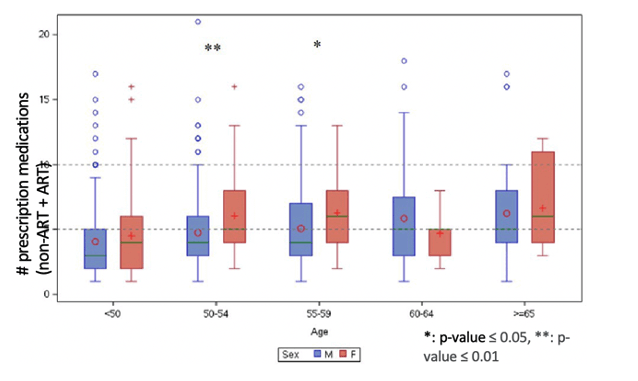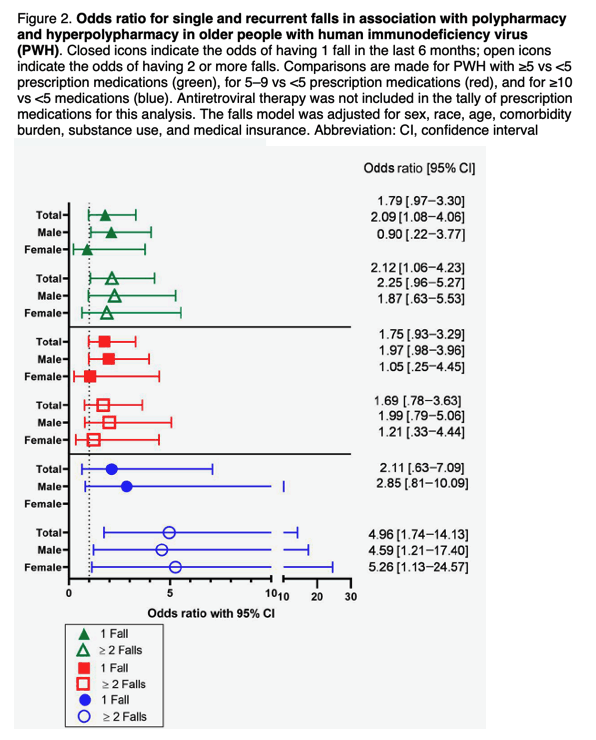| |
Polypharmacy Is Associated With Slow Gait Speed and Recurrent Falls in Older People With HIV- in ACTG HAILO Cohort where average age is only 51
|
| |
| |
Download the PDF here
Our results indicate that polypharmacy and hyperpolypharmacy, in particular, are strongly associated with a higher risk for recurrent falls among PWH.
In multivariable models, the association of polypharmacy was somewhat attenuated but remained associated with higher odds of experiencing recurrent falls (OR = 2.12; 95% CI = 1.06-4.23), and hyperpolypharmacy exacerbated this risk of recurrent falls (OR = 4.96
Consistent with prior reports in the general population, we found that the prevalence of polypharmacy was higher in women than in men [35-37] (30% vs 23%), despite the fact that women had a similar comorbidity burden and had similar HIV-related factors (CD4+ T-cell count and CD4/CD8 ratio) as men in this cohort. Women in this study did differ from men by sociodemographic factors, including race (more likely to identify as Black) and medical insurance status (more likely to report using public insurance). This is consistent with prior studies of the general population where socioeconomic inequalities of polypharmacy are apparent. Socioeconomic status and education are inversely related to polypharmacy, largely due to the increased risk of multimorbidity and poor care coordination among populations of low socioeconomic status [43, 44].
efforts to pinpoint and reduce risk factors for polypharmacy among PWH, including the presence of specific comorbidities and social determinants of health, can potentially mitigate the risk of recurrent falls and associated functional decline.
ART, 24% of study participants had polypharmacy and 4% had hyperpolypharmacy. Polypharmacy was more common in women (30%) than men (23%). ....average age old 51
When ART was included in the total count of prescription medications, 44% had polypharmacy and 8% had hyperpolypharmacy.
Twelve percent of HAILO participants reported at least 1 fall in the last 6 months; 7% reported 1 fall, and 5% reported recurrent (2 or more) falls. A higher prevalence of falls was associated with female sex, Hispanic ethnicity, public medical insurance, and participants aged ≥55 years. Among those who did experience a fall, 3.85% reported a fracture and 22% sought medical attention.
Forty percent of participants exhibited slow gait speed, defined as a 4-meter walk time greater than 4 seconds. This prevalence was higher among Hispanic individuals.
Peripheral neuropathy was the most common comorbidity (40%), followed by diabetes (12%) and chronic kidney disease (10). Twenty-four percent of participants were prescribed 5 or more non-ART medications (Table 1); 4% were prescribed 10 or more non-ART medications. When ART was included in the total count of prescription medications, 44% had polypharmacy and 8% had hyperpolypharmacy. Excluding ART medications, polypharmacy increased with age; 36% of participants aged ≥60 years were prescribed 5 or more non-ART medications compared with 22% aged <60 years.
Supplementary Figure 1. Number of medications at study entry by sex and age


|
|
| |
| |
|
|
|